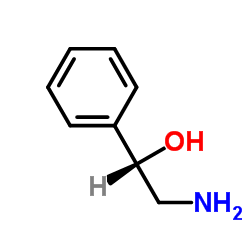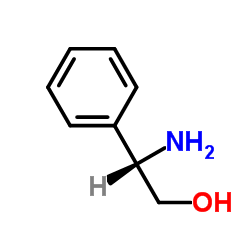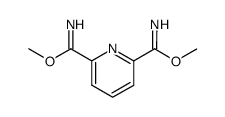2,6-Bis[(4S)-phenyl-2-oxazolin-2-yl]pyridine
![2,6-Bis[(4S)-phenyl-2-oxazolin-2-yl]pyridine Structure](https://image.chemsrc.com/caspic/163/174500-20-0.png)
2,6-Bis[(4S)-phenyl-2-oxazolin-2-yl]pyridine structure
|
Common Name | 2,6-Bis[(4S)-phenyl-2-oxazolin-2-yl]pyridine | ||
|---|---|---|---|---|
| CAS Number | 174500-20-0 | Molecular Weight | 369.416 | |
| Density | 1.3±0.1 g/cm3 | Boiling Point | 600.4±55.0 °C at 760 mmHg | |
| Molecular Formula | C23H19N3O2 | Melting Point | 171-175 °C(lit.) | |
| MSDS | Chinese USA | Flash Point | 316.9±31.5 °C | |
| Symbol |

GHS07 |
Signal Word | Warning | |
| Name | (S,S)-2,2'-(2,6-Pyridinediyl)bis(4-phenyl-2-oxazoline) |
|---|---|
| Synonym | More Synonyms |
| Density | 1.3±0.1 g/cm3 |
|---|---|
| Boiling Point | 600.4±55.0 °C at 760 mmHg |
| Melting Point | 171-175 °C(lit.) |
| Molecular Formula | C23H19N3O2 |
| Molecular Weight | 369.416 |
| Flash Point | 316.9±31.5 °C |
| Exact Mass | 369.147736 |
| PSA | 56.07000 |
| LogP | 3.43 |
| Vapour Pressure | 0.0±1.6 mmHg at 25°C |
| Index of Refraction | 1.674 |
| InChIKey | HLHBIMJNCKZZQO-NHCUHLMSSA-N |
| SMILES | c1ccc(C2COC(c3cccc(C4=NC(c5ccccc5)CO4)n3)=N2)cc1 |
| Water Solubility | Insoluble |
Synonym: Section 2 - COMPOSITION, INFORMATION ON INGREDIENTS
Risk Phrases: 36/37/38 Section 3 - HAZARDS IDENTIFICATION EMERGENCY OVERVIEW
Irritating to eyes, respiratory system and skin. Potential Health Effects Eye: Causes eye irritation. Skin: Causes skin irritation. May be harmful if absorbed through the skin. Ingestion: May cause irritation of the digestive tract. May be harmful if swallowed. Inhalation: Causes respiratory tract irritation. May be harmful if inhaled. Chronic: Not available. Section 4 - FIRST AID MEASURES Eyes: Flush eyes with plenty of water for at least 15 minutes, occasionally lifting the upper and lower eyelids. Get medical aid. Skin: Get medical aid. Flush skin with plenty of water for at least 15 minutes while removing contaminated clothing and shoes. Ingestion: Get medical aid. Wash mouth out with water. Inhalation: Remove from exposure and move to fresh air immediately. If not breathing, give artificial respiration. If breathing is difficult, give oxygen. Get medical aid. Notes to Physician: Treat symptomatically and supportively. Section 5 - FIRE FIGHTING MEASURES General Information: As in any fire, wear a self-contained breathing apparatus in pressure-demand, MSHA/NIOSH (approved or equivalent), and full protective gear. Extinguishing Media: Use water spray, dry chemical, carbon dioxide, or chemical foam. Section 6 - ACCIDENTAL RELEASE MEASURES General Information: Use proper personal protective equipment as indicated in Section 8. Spills/Leaks: Vacuum or sweep up material and place into a suitable disposal container. Avoid generating dusty conditions. Section 7 - HANDLING and STORAGE Handling: Avoid breathing dust, vapor, mist, or gas. Avoid contact with skin and eyes. Storage: Store in a cool, dry place. Store in a tightly closed container. Section 8 - EXPOSURE CONTROLS, PERSONAL PROTECTION Engineering Controls: Facilities storing or utilizing this material should be equipped with an eyewash facility and a safety shower. Use adequate ventilation to keep airborne concentrations low. Exposure Limits CAS# 174500-20-0: Personal Protective Equipment Eyes: Not available. Skin: Wear appropriate protective gloves to prevent skin exposure. Clothing: Wear appropriate protective clothing to prevent skin exposure. Respirators: Follow the OSHA respirator regulations found in 29 CFR 1910.134 or European Standard EN 149. Use a NIOSH/MSHA or European Standard EN 149 approved respirator if exposure limits are exceeded or if irritation or other symptoms are experienced. Section 9 - PHYSICAL AND CHEMICAL PROPERTIES Physical State: Crystals Color: white Odor: odorless pH: Not available. Vapor Pressure: Not available. Viscosity: Not available. Boiling Point: Not available. Freezing/Melting Point: 171 - 175 deg C Autoignition Temperature: Not available. Flash Point: Not available. Explosion Limits, lower: Not available. Explosion Limits, upper: Not available. Decomposition Temperature: Solubility in water: Insoluble. Specific Gravity/Density: Molecular Formula: C23H19N3O2 Molecular Weight: 369.42 Section 10 - STABILITY AND REACTIVITY Chemical Stability: Stable. Conditions to Avoid: Incompatible materials. Incompatibilities with Other Materials: Strong oxidizing agents. Hazardous Decomposition Products: Nitrogen oxides, carbon monoxide, carbon dioxide. Hazardous Polymerization: Will not occur. Section 11 - TOXICOLOGICAL INFORMATION RTECS#: CAS# 174500-20-0 unlisted. LD50/LC50: Not available. Carcinogenicity: 2,6-bis[(4s)-phenyl-2-oxazolin-2-yl]pyridine - Not listed by ACGIH, IARC, or NTP. Section 12 - ECOLOGICAL INFORMATION Section 13 - DISPOSAL CONSIDERATIONS Dispose of in a manner consistent with federal, state, and local regulations. Section 14 - TRANSPORT INFORMATION IATA Not regulated as a hazardous material. IMO Not regulated as a hazardous material. RID/ADR Not regulated as a hazardous material. Section 15 - REGULATORY INFORMATION European/International Regulations European Labeling in Accordance with EC Directives Hazard Symbols: XI Risk Phrases: R 36/37/38 Irritating to eyes, respiratory system and skin. Safety Phrases: S 26 In case of contact with eyes, rinse immediately with plenty of water and seek medical advice. S 37/39 Wear suitable gloves and eye/face protection. WGK (Water Danger/Protection) CAS# 174500-20-0: No information available. Canada None of the chemicals in this product are listed on the DSL/NDSL list. CAS# 174500-20-0 is not listed on Canada's Ingredient Disclosure List. US FEDERAL TSCA CAS# 174500-20-0 is not listed on the TSCA inventory. It is for research and development use only. SECTION 16 - ADDITIONAL INFORMATION N/A |
| Symbol |

GHS07 |
|---|---|
| Signal Word | Warning |
| Hazard Statements | H315-H319-H335 |
| Precautionary Statements | P261-P305 + P351 + P338 |
| Personal Protective Equipment | dust mask type N95 (US);Eyeshields;Gloves |
| Hazard Codes | Xi:Irritant; |
| Risk Phrases | R36/37/38 |
| Safety Phrases | S26-S36/37/39-S37/39 |
| RIDADR | NONH for all modes of transport |
| WGK Germany | 3 |
|
~74% ![2,6-Bis[(4S)-phenyl-2-oxazolin-2-yl]pyridine Structure](https://image.chemsrc.com/caspic/163/174500-20-0.png)
2,6-Bis[(4S)-ph... CAS#:174500-20-0 |
| Literature: Schaus; Jacobsen Organic letters, 2000 , vol. 2, # 7 p. 1001 - 1004 |
|
~70% ![2,6-Bis[(4S)-phenyl-2-oxazolin-2-yl]pyridine Structure](https://image.chemsrc.com/caspic/163/174500-20-0.png)
2,6-Bis[(4S)-ph... CAS#:174500-20-0 |
| Literature: Kim, Hae-Jo; Asif, Riaz; Chung, Doo Soo; Hong, Jong-In Tetrahedron Letters, 2003 , vol. 44, # 23 p. 4335 - 4338 |
|
~52% ![2,6-Bis[(4S)-phenyl-2-oxazolin-2-yl]pyridine Structure](https://image.chemsrc.com/caspic/163/174500-20-0.png)
2,6-Bis[(4S)-ph... CAS#:174500-20-0 |
| Literature: Redlich, Mark; Hossain, M. Mahmun Tetrahedron Letters, 2004 , vol. 45, # 49 p. 8987 - 8990 |
|
~72% ![2,6-Bis[(4S)-phenyl-2-oxazolin-2-yl]pyridine Structure](https://image.chemsrc.com/caspic/163/174500-20-0.png)
2,6-Bis[(4S)-ph... CAS#:174500-20-0 |
| Literature: Cornejo; Fraile; Garcia; Gil; Martinez-Merino; Mayoral; Pires; Villalba Synlett, 2005 , # 15 art. no. G13005ST, p. 2321 - 2324 |
|
~% ![2,6-Bis[(4S)-phenyl-2-oxazolin-2-yl]pyridine Structure](https://image.chemsrc.com/caspic/163/174500-20-0.png)
2,6-Bis[(4S)-ph... CAS#:174500-20-0 |
| Literature: Tetrahedron Letters, , vol. 45, # 49 p. 8987 - 8990 |
|
~% ![2,6-Bis[(4S)-phenyl-2-oxazolin-2-yl]pyridine Structure](https://image.chemsrc.com/caspic/163/174500-20-0.png)
2,6-Bis[(4S)-ph... CAS#:174500-20-0 |
| Literature: Tetrahedron Letters, , vol. 46, # 27 p. 4543 - 4546 |
|
~% ![2,6-Bis[(4S)-phenyl-2-oxazolin-2-yl]pyridine Structure](https://image.chemsrc.com/caspic/163/174500-20-0.png)
2,6-Bis[(4S)-ph... CAS#:174500-20-0 |
| Literature: Tetrahedron Letters, , vol. 45, # 49 p. 8987 - 8990 |
|
~% ![2,6-Bis[(4S)-phenyl-2-oxazolin-2-yl]pyridine Structure](https://image.chemsrc.com/caspic/163/174500-20-0.png)
2,6-Bis[(4S)-ph... CAS#:174500-20-0 |
| Literature: Tetrahedron Letters, , vol. 46, # 27 p. 4543 - 4546 |
| 2,6-Bis((S)-4-phenyl-4,5-dihydrooxazol-2-yl)pyridine |
| Pyridine, 2,6-bis[(4S)-4,5-dihydro-4-phenyl-2-oxazolyl]- |
| 2,6-Bis[(4S)-phenyl-2-(oxazolin-2-yl)]pyridine |
| 2,6-Bis[4S-4-phenyl-2-oxazolinyl]pyridine |
| 2,6-Bis[(4S)-phenyl-2-oxazolin-2-yl]pyridine |
| 2,6-Bis[(4S)-4-phenyl-4,5-dihydro-1,3-oxazol-2-yl]pyridine |
| (S,S)-2,6-Bis(4,5-dihydro-4-phenyl-2-oxazolyl)pyridine |
| (S,S)-2,6-Bis(4-phenyl-2-oxazolin-2-yl)pyridine |
| (4S)-4-phenyl-2-[6-[(4S)-4-phenyl-4,5-dihydro-1,3-oxazol-2-yl]pyridin-2-yl]-4,5-dihydro-1,3-oxazole |
| (S,S)-2,6-Bis(4-phenyl-2-oxazolinyl)pyridine |
| MFCD01863586 |
| 2,6-Bis[(4S)-4-phenyl-2-oxazolinyl]pyridine |








